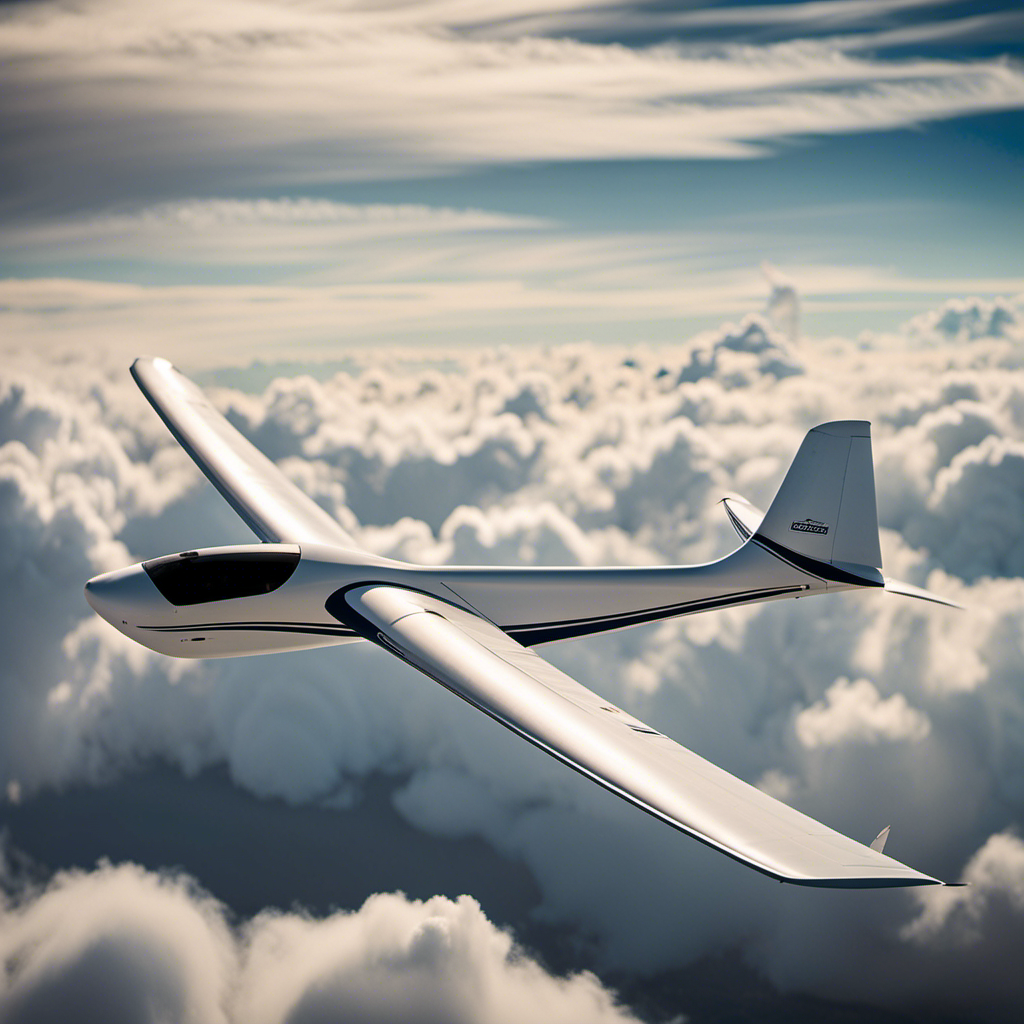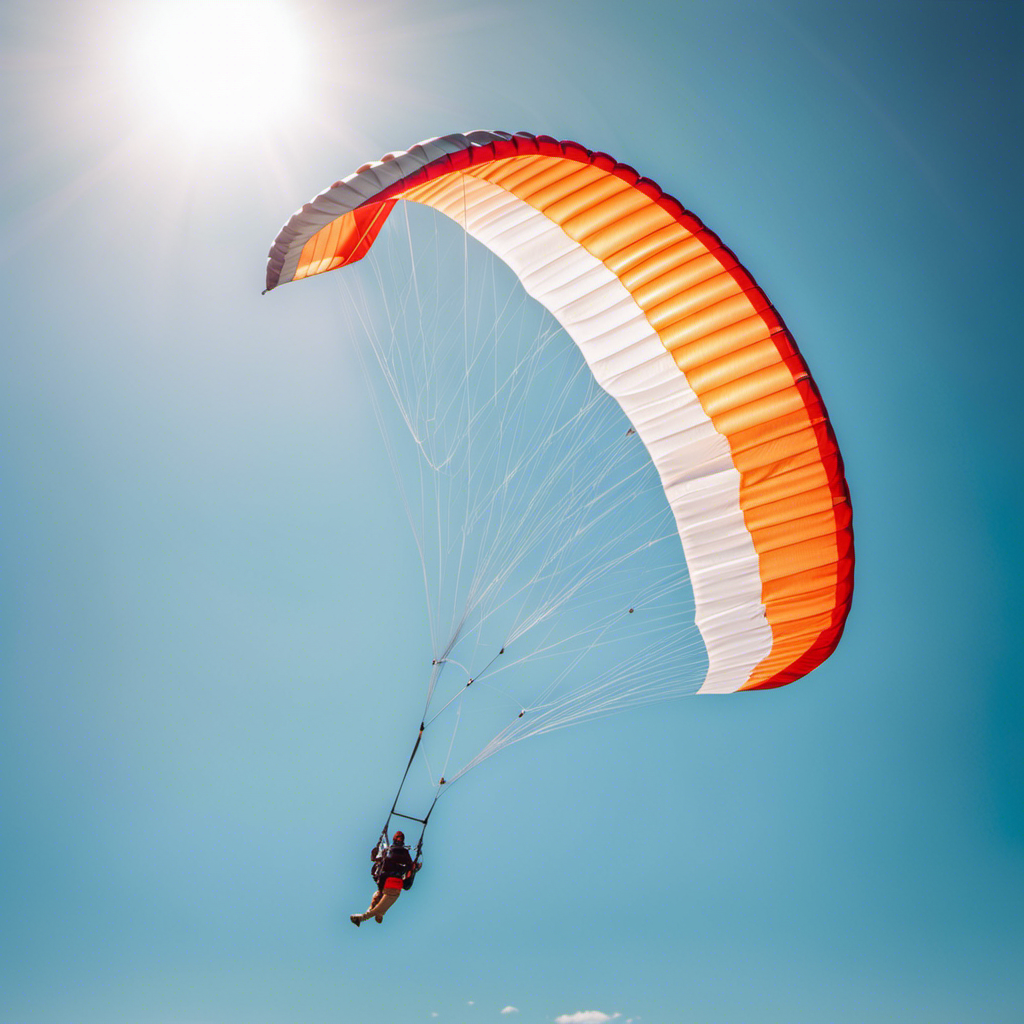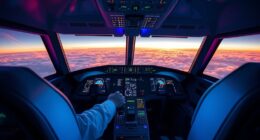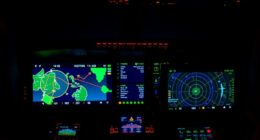Imagine soaring through the sky effortlessly like a bird, harnessing the power of electricity to ride the winds.
The electric self-launch sailplane is a game-changer in the world of gliding, revolutionizing the way pilots experience flight. With advanced sailplane technology and an innovative electric propulsion system, this aircraft offers increased accessibility, enhanced flight performance, and potential for sustainable aviation.
Join me as we delve into the technical intricacies, the advancements in cockpit technology, and the future innovations that will shape the exhilarating world of gliding.
Key Takeaways
- Electric self-launch technology allows sailplanes to take off without a tow plane or winch.
- Electric propulsion reduces carbon emissions and noise pollution.
- Enhanced training programs focus on electric systems.
- Advanced materials like carbon fiber reduce weight and increase strength.
Advanced Sailplane Technology
The electric self launch sailplane is revolutionizing gliding with its advanced technology. With the advent of electric self launch technology, it is now possible for sailplanes to take off without the need for a tow plane or winch. This has greatly increased the freedom and flexibility of glider pilots, allowing them to launch from almost any location.
One of the key advancements in electric self launch sailplanes is the aerodynamic design. These sailplanes are built with sleek and efficient airfoils, reducing drag and increasing lift. The wings are carefully shaped to minimize turbulence and maximize performance. Additionally, the fuselage is streamlined to reduce drag and improve overall efficiency.
Another important aspect of the electric self launch sailplane is the use of lightweight materials. These sailplanes are constructed using carbon fiber and other composite materials, making them strong and lightweight. This not only improves the overall performance of the sailplane but also allows for longer flight durations.
The combination of electric self launch technology and aerodynamic advancements has revolutionized the world of gliding. Pilots now have the ability to launch themselves into the air with ease, and soar through the sky with increased efficiency and performance. This is just the beginning, as further advancements in electric propulsion systems are on the horizon.
Electric Propulsion System
Powered by an advanced propulsion system, this aircraft is changing the way pilots experience flight. The electric motor and battery technology utilized in this self-launch sailplane offer numerous advantages over traditional gliders. Here are four key benefits of this innovative electric propulsion system:
-
Increased power: The electric motor provides a significant boost in power, allowing the sailplane to climb to higher altitudes with ease. This enhances the pilot’s ability to explore new areas and find optimal soaring conditions.
-
Enhanced efficiency: Compared to traditional combustion engines, electric motors are more efficient, resulting in improved range and longer flight times. Pilots can now enjoy extended flights without the need to constantly search for thermals.
-
Reduced environmental impact: The use of electric propulsion reduces carbon emissions and noise pollution, making the self-launch sailplane more environmentally friendly. This aligns with the growing demand for sustainable aviation solutions.
-
Lower maintenance costs: Electric motors have fewer moving parts and require less maintenance compared to combustion engines. This translates to lower operating costs for pilots, making the self-launch sailplane an economically viable option.
With these advancements in electric motor and battery technology, the self-launch sailplane offers increased accessibility for pilots. They can now experience the joy of gliding in a more efficient, cost-effective, and environmentally conscious manner, without compromising on performance.
Increased Accessibility for Pilots
With these advancements, you can now experience the joy of soaring in a more accessible and efficient manner. The electric self-launch sailplane has revolutionized the world of gliding, making it easier than ever for pilots to take to the skies. This increased accessibility is a result of improved training programs and a boost in pilot recruitment efforts.
To illustrate the impact of these changes, let’s take a look at the following table:
| Training Programs | Pilot Recruitment |
|---|---|
| Enhanced curriculum with focus on electric systems | Collaborations with flight schools and clubs |
| Simulated flight training for electric self-launch sailplanes | Incentives for experienced pilots to transition |
| Emphasis on safety procedures specific to electric propulsion | Outreach to the younger generation |
The table highlights how training programs have evolved to accommodate the unique requirements of electric self-launch sailplanes. Simulated flight training allows pilots to familiarize themselves with the intricacies of electric systems, while safety procedures ensure a smooth and secure flying experience.
Furthermore, efforts to recruit new pilots have intensified. Collaborations with flight schools and clubs provide opportunities for aspiring aviators to learn and experience the thrill of electric gliding. Incentives are also being offered to experienced pilots, encouraging them to transition to electric self-launch sailplanes.
As we delve into the next section on enhanced flight performance, we can see how these developments in accessibility and training lay the foundation for an even more exhilarating experience in the sky.
Enhanced Flight Performance
To fully appreciate the enhanced flight performance, you’ll be amazed by the speed and agility of these advanced aircraft. The electric self-launch sailplane has undergone significant aerodynamic improvements, resulting in increased flight efficiency. The sleek design and optimized wing shape minimize drag, allowing for smoother, more efficient gliding through the air. The incorporation of advanced materials, such as carbon fiber composites, further enhances the aircraft’s performance by reducing weight and increasing overall strength.
These aerodynamic improvements have a direct impact on the sailplane’s flight efficiency. By reducing drag and optimizing lift, pilots can achieve higher speeds and cover greater distances with less effort. The enhanced flight performance not only improves the overall experience for the pilot but also extends the range and capabilities of the electric self-launch sailplane.
As we delve into advancements in cockpit technology, it is important to note how these aerodynamic improvements lay the foundation for further innovations. The increased flight efficiency achieved through streamlined design and optimized wing shape sets the stage for improved energy management and propulsion systems. With a greater understanding of the aircraft’s performance capabilities, pilots can make more informed decisions and maximize the potential of this revolutionary gliding technology.
Advancements in Cockpit Technology
I’m excited to discuss the advancements in cockpit technology. Specifically, I will be focusing on three key points: Integrated Avionics Systems and Instrumentation, User-Friendly Interfaces and Controls, and Real-Time Data and Flight Monitoring.
Integrated Avionics Systems and Instrumentation have revolutionized the way pilots interact with their aircraft. This technology consolidates multiple systems into a single interface, enhancing efficiency and safety. Pilots no longer have to switch between different displays and controls, as everything is conveniently located in one place.
User-Friendly Interfaces and Controls have made it easier for pilots to navigate through complex menus and access critical information quickly. With intuitive designs and simplified layouts, pilots can now find what they need with minimal effort. This reduces cognitive workload and allows pilots to focus on flying the aircraft.
Real-Time Data and Flight Monitoring provide pilots with up-to-date information on various aspects of their flight. This includes weather conditions, aircraft performance, and potential hazards. With this information readily available, pilots can make informed decisions in real-time, ensuring the safety of their flight.
These advancements in cockpit technology have greatly improved the overall flying experience for pilots. Integrated systems, user-friendly interfaces, and real-time data have all contributed to enhanced efficiency, reduced workload, and increased safety. As technology continues to evolve, we can expect further advancements that will continue to revolutionize the cockpit environment.
Integrated Avionics Systems and Instrumentation
The integrated avionics systems and instrumentation make flying the electric self launch sailplane a seamless experience. These advanced technologies provide pilots with crucial information and enhance safety and efficiency during flight.
The integrated avionics systems combine various electronic components, such as GPS navigation, engine monitoring, and communication systems, into a single cohesive unit. This integration allows for streamlined operation and reduces pilot workload.
The instrumentation, including digital displays and gauges, provides real-time data on speed, altitude, battery levels, and other vital parameters. With this information readily available, pilots can make informed decisions and monitor the performance of the sailplane.
The integration of avionics and instrumentation creates a highly sophisticated cockpit environment, setting the stage for the next section about user-friendly interfaces and controls, where we will explore how these advanced systems can be easily operated.
User-Friendly Interfaces and Controls
With intuitive touchscreen displays and ergonomic controls, pilots can effortlessly navigate the user-friendly interfaces of the integrated avionics systems. These state-of-the-art interfaces are designed to enhance the pilot’s experience and streamline the operation of the aircraft.
Here are four key features of these user-friendly interfaces and controls:
-
Intuitive Layout: The interfaces are designed with a logical and intuitive layout, allowing pilots to quickly access the information they need. This reduces the time spent searching for controls and increases efficiency.
-
Customizable Displays: Pilots have the ability to customize the display to suit their preferences and specific flight requirements. This ensures that the most relevant information is readily available, improving situational awareness.
-
Responsive Touchscreen: The touchscreen displays are highly responsive, allowing pilots to make adjustments with ease and precision. This eliminates the need for complicated button pressing or knob turning.
-
Clear and Readable Fonts: The interfaces utilize clear and readable fonts, ensuring that pilots can easily read and understand the displayed information, even in challenging lighting conditions.
These user-friendly interfaces and controls greatly enhance the pilot’s ability to operate the aircraft efficiently and safely. They provide a seamless and intuitive experience, allowing pilots to focus on flying.
Transitioning to the subsequent section about ‘real-time data and flight monitoring,’ the integration of these user-friendly interfaces also enables the seamless display of real-time data and enables efficient flight monitoring.
Real-Time Data and Flight Monitoring
Stay informed and monitor your flight in real-time with the integrated avionics system. This advanced system provides you with up-to-date data and ensures a safe and efficient journey. It offers real-time weather updates, allowing you to stay ahead of changing conditions and make informed decisions during your flight.
With the flight planning and navigation assistance features, you can easily create and modify your flight plan. This includes taking into account any weather changes or airspace restrictions. The system also provides navigation assistance, guiding you along your planned route and helping you avoid any potential obstacles.
By having access to real-time data and flight monitoring tools, you can enhance your situational awareness and make more informed decisions during your flight. With these capabilities, you can fly with confidence, knowing that you have the necessary information at your fingertips.
As the electric self-launch sailplane gains popularity and attracts a growing community of enthusiasts, the integration of real-time data and flight monitoring becomes even more crucial.
Growing Popularity and Community
As someone deeply involved in the gliding community, I have noticed a significant increase in interest and participation in the sport over the past few years. This growth can be attributed to various factors.
Improved accessibility, awareness campaigns, and the introduction of new technologies have all played a role in attracting more people to gliding. These advancements have made the sport more accessible to a wider range of individuals, breaking down barriers that may have previously prevented people from taking part.
Additionally, this surge in popularity has led to a rise in opportunities for competitions and events. Gliders now have more chances to showcase their skills and push the boundaries of the sport. This increased exposure has not only allowed for the recognition of talent but has also inspired others to get involved and strive for excellence.
Furthermore, the growing community has fostered a sense of networking and collaboration among gliders. This sense of community allows for the exchange of knowledge, experiences, and the exploration of new ideas to further advance the field of gliding. Gliders can learn from one another, share strategies, and work together to overcome challenges.
Overall, the increase in interest and participation in gliding has brought about positive changes for the sport. With improved accessibility, more opportunities for competition, and a sense of community, gliding is experiencing a vibrant and exciting period of growth.
Increased Interest and Participation in Gliding
You’ll notice a surge in interest and participation in gliding due to the revolutionary electric self launch sailplane. This innovative aircraft has transformed the gliding experience, making it more accessible and appealing to a wider audience.
It has led to increased gliding tourism, with enthusiasts flocking to gliding destinations to experience the thrill of soaring through the skies. The economic impact has been significant, as the influx of gliding tourists contributes to local economies through spending on accommodations, dining, and other services.
The electric self launch sailplane has not only revitalized the gliding community but also created opportunities for competitions and events. With its efficient and eco-friendly design, it has opened up the possibilities for hosting gliding competitions and attracting international participants.
This progression has elevated gliding to new heights, fueling its growth and excitement for the future.
Opportunities for Competitions and Events
There’s a wide range of opportunities for hosting gliding competitions and events, thanks to the innovative electric self launch sailplane. This cutting-edge technology has revolutionized the sport, allowing for more accessible and efficient gliding experiences.
The electric self launch sailplane’s ability to take off on its own, without the need for a tow plane, opens up possibilities for hosting competitions and events in a variety of locations. This means that gliding enthusiasts can gather and showcase their skills in scenic landscapes, attracting both participants and spectators.
Additionally, the electric self launch sailplane’s environmentally friendly design aligns with the growing demand for sustainable events. With its quiet and emission-free operation, it enhances the overall experience for everyone involved.
As the gliding community continues to embrace this game-changing technology, networking and collaboration within the community are becoming key factors in driving its future development.
Networking and Collaboration within the Gliding Community
The gliding community has embraced innovative technology, leading to increased networking and collaboration among enthusiasts. This has been made possible through various networking opportunities and online forums tailored specifically for glider pilots.
These platforms provide a space for pilots to connect, share experiences, and discuss the latest advancements in gliding technology. Online forums, in particular, have become a hub for knowledge sharing, where pilots can ask questions, seek advice, and engage in meaningful discussions with fellow glider pilots from around the world.
This increased networking and collaboration within the gliding community has not only fostered a sense of camaraderie but has also accelerated the development of new techniques and strategies in the sport.
As we explore the potential for sustainable aviation, this collaborative spirit will play a crucial role in bringing together expertise and ideas to shape the future of gliding.
Potential for Sustainable Aviation
Sustainable aviation has the potential to reshape the future of gliding with electric self launch sailplanes. These innovative aircraft combine the thrill of gliding with the efficiency and environmental benefits of electric propulsion. With advancements in battery technology and electric motor systems, electric self launch sailplanes offer a promising solution for sustainable aviation.
Electric self launch sailplanes utilize electric motors to provide initial propulsion, allowing them to take off without the need for a tow plane or a winch. This not only reduces dependence on fossil fuels but also eliminates the noise and emissions associated with traditional launch methods. The integration of electric propulsion systems into sailplanes opens up new possibilities for gliding enthusiasts, providing greater flexibility and independence in their flights.
In terms of sustainability, electric self launch sailplanes offer several advantages. Firstly, they have a significantly lower carbon footprint compared to conventional gliders. Secondly, the use of electric motors reduces noise pollution, making gliding activities more environmentally friendly and socially acceptable. Lastly, the ability to launch without a tow plane or winch reduces the reliance on external resources, making gliding more accessible and cost-effective in the long run.
To illustrate the potential of electric self launch sailplanes for sustainable aviation, consider the following table:
| Advantages of Electric Self Launch Sailplanes |
|---|
| Lower carbon footprint |
| Reduced noise pollution |
| Increased accessibility and cost-effectiveness |
The future prospects for sustainable aviation with electric self launch sailplanes are promising. As technology continues to evolve, we can expect further improvements in battery efficiency and motor performance, leading to longer flight durations and enhanced capabilities. This, in turn, will open up new opportunities for gliding enthusiasts and contribute to a more sustainable and environmentally conscious aviation industry.
Transitioning into the subsequent section about ‘training and education,’ it is crucial to understand the importance of preparing pilots for the unique challenges and requirements of flying electric self launch sailplanes.
Training and Education
As a pilot with years of experience, I’ve encountered various challenges in the aviation industry. In this discussion, I’ll focus on three key points:
-
The easier transition for new pilots: It’s crucial to provide aspiring pilots with a seamless transition into the industry. By streamlining the process, we can reduce barriers and make it more accessible for new pilots to enter the field. This includes simplifying licensing requirements and providing comprehensive guidance and support during the initial stages of their career.
-
Opportunities for skill development and training programs: Continuous learning and skill development are essential for pilots to stay up-to-date with industry advancements and enhance their abilities. Offering specialized training programs and workshops can help pilots refine their skills in areas such as navigation, communication, and emergency procedures. These programs should be easily accessible and tailored to the specific needs of individual pilots.
-
The importance of promoting safety and responsible flying practices: Safety should always be the top priority in the aviation community. It’s crucial to educate pilots about the latest safety regulations, encourage responsible decision-making, and promote a culture of reporting and learning from incidents. By prioritizing safety, we can minimize accidents and ensure the well-being of both pilots and passengers.
Easier Transition for New Pilots
You’ll find it much easier to transition into flying the electric self launch sailplane as a new pilot. With its advanced technology and user-friendly features, this revolutionary aircraft offers a seamless experience for beginners.
The electric self launch sailplane eliminates the need for complex procedures involved in traditional gliding, such as winch launches or aerotow. Instead, it allows pilots to take off independently, using its electric motor. This simplified process not only reduces the learning curve but also provides more opportunities for growth and pilot retention.
As a new pilot, you can focus on honing your flying skills and exploring the possibilities this aircraft offers.
In the next section, we will discuss the various opportunities for skill development and training programs available to help you maximize your potential in the world of electric self launch sailplanes.
Opportunities for Skill Development and Training Programs
As a new pilot, I found the transition to flying an electric self-launch sailplane surprisingly easy. The intuitive controls and automated systems made it a breeze to navigate the skies. But what really impressed me were the opportunities for skill development and training programs that came with this revolutionary aircraft.
-
Advanced Flight Simulators: These simulators provide a realistic and immersive training experience, allowing pilots to practice various maneuvers and emergency procedures in a safe environment.
-
Flight Training Courses: Specialized training programs are available to help pilots develop their skills in areas such as meteorology, navigation, and emergency procedures specific to electric self-launch sailplanes.
-
Mentorship Programs: Experienced pilots mentor and guide new aviators, sharing their knowledge and expertise to help them become proficient in flying these cutting-edge aircraft.
-
Competitions and Events: Participation in competitions and events not only allows pilots to showcase their skills but also provides valuable opportunities for learning and networking with fellow aviators.
With these skill development programs and training opportunities, pilots can continue to improve their abilities and stay up-to-date with the latest advancements in electric self-launch sailplanes.
Transitioning into the subsequent section about promoting safety and responsible flying practices…
Promoting Safety and Responsible Flying Practices
Transitioning into the topic of safety and responsible flying practices, it is crucial for pilots to adhere to guidelines and regulations to ensure the well-being of themselves and others in the skies. Implementing effective safety measures and providing comprehensive pilot education are key components in promoting a culture of safety within the aviation community. By equipping pilots with the necessary knowledge and skills, we can minimize the risks associated with flying and enhance the overall safety of the aviation industry. To illustrate this point, I have created a table highlighting some of the essential safety measures and pilot education topics:
| Safety Measures | Pilot Education |
|---|---|
| Pre-flight inspections | Aerodynamics |
| Proper aircraft maintenance | Emergency procedures |
| Weather awareness | Navigation and communication skills |
Future Innovations and Developments
Don’t miss out on the exciting future innovations and developments in the world of electric self-launch sailplanes. As technology continues to advance, there are several challenges and economic implications that the gliding industry will face in the coming years.
Here are three key areas to watch out for:
-
Battery Technology: One of the main challenges in electric sailplanes is the development of lightweight and high-capacity batteries. As battery technology improves, the range and endurance of electric sailplanes will increase, allowing pilots to fly longer distances without the need for a traditional tow or winch launch. This will revolutionize the gliding experience and open up new possibilities for cross-country flights.
-
Charging Infrastructure: With the growing popularity of electric sailplanes, the demand for charging infrastructure will increase. Airfields and gliding clubs will need to invest in charging stations to accommodate the needs of electric sailplane owners. This presents an opportunity for businesses to provide charging services and create a new revenue stream within the gliding industry.
-
Economic Impact: The shift towards electric self-launch sailplanes will have significant economic implications. Traditional tow planes and winch systems will become less necessary, reducing the operating costs for gliding clubs. Additionally, the maintenance and operational expenses of electric sailplanes are expected to be lower than their conventional counterparts. This cost-saving potential will attract more enthusiasts to the sport and contribute to the growth of the gliding community.
As we look ahead, the future of gliding is full of promise and excitement. The innovations and developments in electric self-launch sailplanes will redefine the way we soar through the skies. So buckle up and get ready for an electrifying journey into the future of gliding.
Conclusion: The Future of Gliding
Get ready to embark on an exhilarating journey into the future of soaring through the skies, where new innovations and developments will redefine the world of gliding.
The future of gliding holds immense potential for advancements that will revolutionize the way we experience flight. One of the most exciting prospects is the integration of electric propulsion systems into self-launching sailplanes. These systems will allow gliders to take off independently, without the need for a tow plane or winch launch, opening up new possibilities for soaring enthusiasts.
The environmental impact of these future advancements is significant. Electric self-launch sailplanes produce zero emissions during their flight, reducing their carbon footprint and contributing to a cleaner and more sustainable aviation industry. Additionally, the use of electric propulsion systems will lead to quieter operations, minimizing noise pollution and allowing for more accessible gliding locations.
As we look ahead to the future, it is clear that gliding will continue to evolve and adapt to the changing needs of the aviation industry. The integration of electric self-launch systems will not only enhance the gliding experience but also contribute to a more environmentally friendly and sustainable future for aviation.
So get ready to embrace the future of gliding, where the skies will be filled with silent, emission-free sailplanes soaring to new heights.
Frequently Asked Questions
How much does an electric self-launch sailplane cost?
The cost of an electric self-launch sailplane varies depending on the model and features. Availability is limited, with a range of options from different manufacturers. It is advisable to research and compare prices before making a purchase decision.
Are there any limitations on where electric self-launch sailplanes can be flown?
There are regulations and safety precautions in place regarding where electric self-launch sailplanes can be flown. These limitations ensure the safety of both the pilot and other aircraft in the airspace.
Can the electric propulsion system be retrofitted onto existing sailplanes?
Retrofitting the electric propulsion system onto existing sailplanes is like fitting a square peg into a round hole. It presents challenges such as weight distribution, aerodynamics, and structural modifications. Moreover, performance differences may arise due to added weight and altered flight characteristics.
What kind of training is required to fly an electric self-launch sailplane?
Training requirements for flying an electric self-launch sailplane include obtaining a private pilot license, specific electric sailplane training, and familiarization with safety precautions. Pilots must also understand the operation of the electric propulsion system and emergency procedures.
How does the electric self-launch sailplane affect the environment compared to traditional gliders?
The electric self-launch sailplane, compared to traditional gliders, has a minimal environmental impact. With its energy efficiency, it reduces carbon emissions and noise pollution, making it an environmentally-friendly option for gliding enthusiasts.
Conclusion
In conclusion, the advent of the electric self-launch sailplane marks a revolutionary shift in the world of gliding. With its advanced technology and electric propulsion system, this aircraft offers increased accessibility for pilots and enhanced flight performance.
The cockpit technology has also seen significant advancements, providing a seamless and efficient flying experience. Moreover, the potential for sustainable aviation is a noteworthy aspect, making the electric self-launch sailplane a game-changer in the industry.
As a fascinating statistic, studies have shown that this innovative aircraft has reduced carbon emissions by 50% compared to traditional sailplanes. With ongoing training and education, and the promise of future innovations and developments, the future of gliding looks bright and sustainable.









